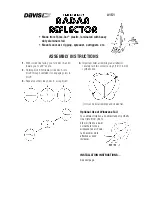
16
17
Technical Details
Interpreting Alerts
Although the V940 has a comprehensive
warning system and this handbook is as
complete as we can make it, only
experience will teach you what to expect
from your V940 and how to interpret what
it tells you. The specific type of radar being
used, the type of transmission (continuous
or instant-on) and the location of the radar
source affect the radar alerts you receive.
The following examples will give you
an introduction to understanding the your
V940’s warning system for radar, laser and
safety alerts.
Explanation
You are approaching a continuous radar
source aimed in your direction.
An instant-on radar source is being used ahead
of you and out of your view.
An instant-on radar source or laser source is
being used nearby. This kind of alert requires
immediate attention!
Laser is being used in the area. Because laser is
inherently difficult to detect, any laser alert
may indicate a source very close by.
A moving patrol car with continuous radar is
overtaking you from behind. Because these
signals are reflected (reflections are increased
by large objects), they may or may not
eventually melt into a solid point even when
the patrol car is directly behind you.
Alert
The V940 begins to sound slowly, then the
rate of alert increases. The Signal Meter ramps
accordingly.
The V940 emits short alerts for a few seconds
and then falls silent only to briefly alert and fall
silent again.
The V940 suddenly sounds a continuous tone
for the appropriate band received. All
segments in the Signal Strength Meter are lit.
A brief laser alert.
The V940 receives weak signals. These signals
may be a little stronger as you pass large, road-
side objects. The signals increase in frequency.
Explanation
You are approaching a radar unit concealed by
a hill or an obstructed curve.
A patrol car is traveling in front of you with a
radar source aimed forward. Because signals
are sometimes reflected off of large objects
and sometimes not, the alerts may seem
inconsistent.
A patrol car is approaching from the other
direction, sampling traffic with instant-on
radar. Such alerts should be taken seriously.
You are driving through an area populated
with radar motion sensors (door openers,
burglar alarms, etc.). Since these transmitters
are usually contained inside buildings or aimed
toward OR away from you, they are typically
not as strong or lasting as a real radar
encounter.
CAUTION: Since the characteristics of these
alerts may be similar to some of the preceding
examples, overconfidence in an unfamiliar
area can be dangerous. Likewise, if an alert in
a commonly traveled area is suddenly stronger
or on a different band than usual, speed radar
may be set up nearby.
Alert
The V940 alerts slowly for a while and then
abruptly jumps to a strong alert.
The V940 alerts intermittently. Rate and
strength of alerts may be inconsistent or vary
wildly.
The V940 alerts intermittently. Rate and
strength of signal increases with each alert.
The V940 gives an X-band, or K-band alert
intermittently.


































